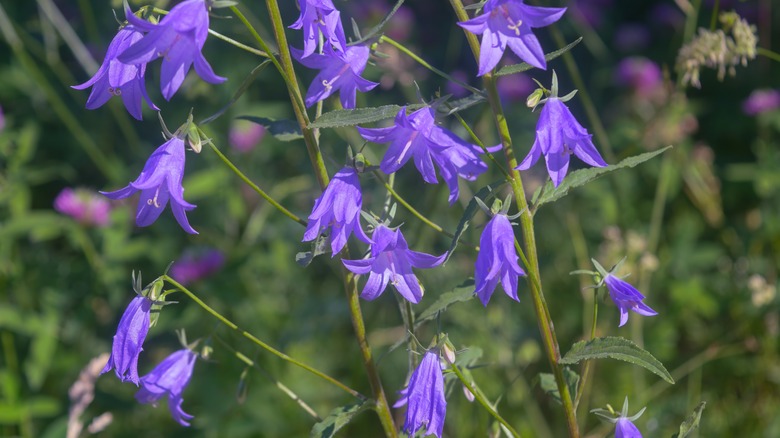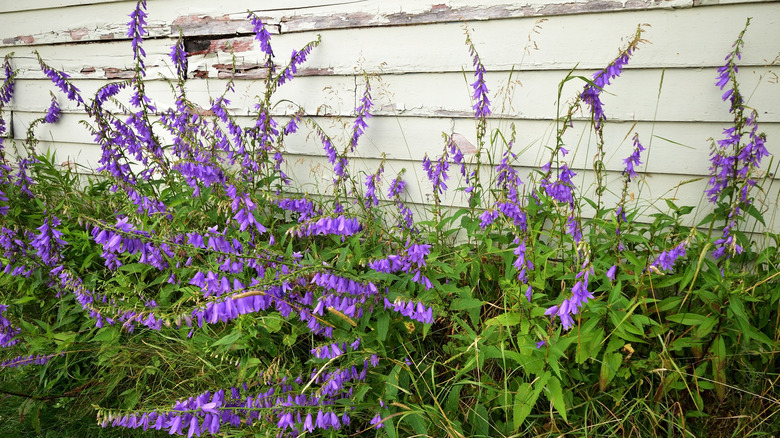Add This Eye-Catching Plant To Your Garden And You'll Immediately Regret It
Not all pretty things in life are good, especially when you look at nature. Venomous snakes, poisonous plants, and dangerous animals can be brightly colored and interesting to look at but never something you should bring too close to home. Some weeds can also be quite beautiful, and creeping bellflower (Campanula rapunculoides) is a classic example. With lovely bell-shaped blooms and long, tantalizing stems, this European plant is undeniably attractive, but the problem with creeping bellflower is that it's an incredibly invasive plant you should never grow. This perennial noxious weed rarely stays where it's planted and spreads extremely fast. Once it escapes its enclosure, creeping bellflower can overpower native vegetation, suffocate other plants in your garden, and harm the local ecosystem as a whole.
Years ago, gardeners frequently planted creeping bellflower, but they quickly learned from their mistakes. You may still see creeping bellflower for sale at your local nursery or offered up for free by a community gardening group, but resist the temptation to bring home these purple blooms. Here's how to recognize creeping bellflower, how to handle an invasion, and some similar-looking flowers that are safer to keep in your garden.
The truth about creeping bellflower
Creeping bellflower is native to Europe and Western Siberia but was brought into North America, where it thrives in hardiness zones 3 through 9. You can easily recognize creeping bellflower from its purple flowers, which are arranged in a line on one side of the stem and have five pointed petals with thin, yellow stamens. The leaves of the plant are bright green and about 4 inches long, with heart-shaped leaves at the bottom and more lance-shaped leaves at the top.
While it might be pretty, creeping bellflower refuses to be contained and can quickly escape garden beds and take over the whole neighborhood. The flowers are extremely attractive to bees and other pollinators — another reason why gardeners loved creeping bellflower before it became invasive. This plant spreads through both seeds and long horizontal roots. Each plant can drop up to 15,000 new seeds, and even the leaves of creeping bellflower have been shown to take root if they fall from the plant. In other words, this plant does everything possible to spread quickly and avoid being eradicated, and so far it has been very successful.
Removing and replacing creeping bellflower
Eradicating creeping bellflower from a garden is notoriously difficult, but it isn't impossible. Before doing anything, ensure that your plants are indeed creeping bellflower and not one of its many native lookalikes. Creeping bellflower blooms in summer, which is the best time to look closely at their leaves and petals to identify them. For the best results during removal, you'll need to frequently cut, deadhead, and pull the above-ground part of the plant to reduce seeds, then dig out the roots. Leaving behind any hair-like root pieces can result in more bellflower plants, so you'll have to dig out a good portion of the surrounding soil, 9 inches around and 9 inches deep. Do not compost your creeping bellflowers, and either burn them promptly or dispose of them in a closed garbage bag.
Even with the most attentive pulling and digging, you're bound to have some creeping bellflowers grow back. With consistent eradication, you may at least keep them contained in a corner of your garden. As a last resort, some people use herbicides to remove creeping bellflower. The plant is resistant to many commercial herbicides, but Clopyralid-containing pesticides have been found to be the most effective.
Love the charming look of creeping bellflower but not its unruly behavior? There are plenty of similar-looking native plants that are much easier to maintain and better for the environment. Check out harebells, ladybells, American bellflower, native bluebells, and other campanula varieties.

